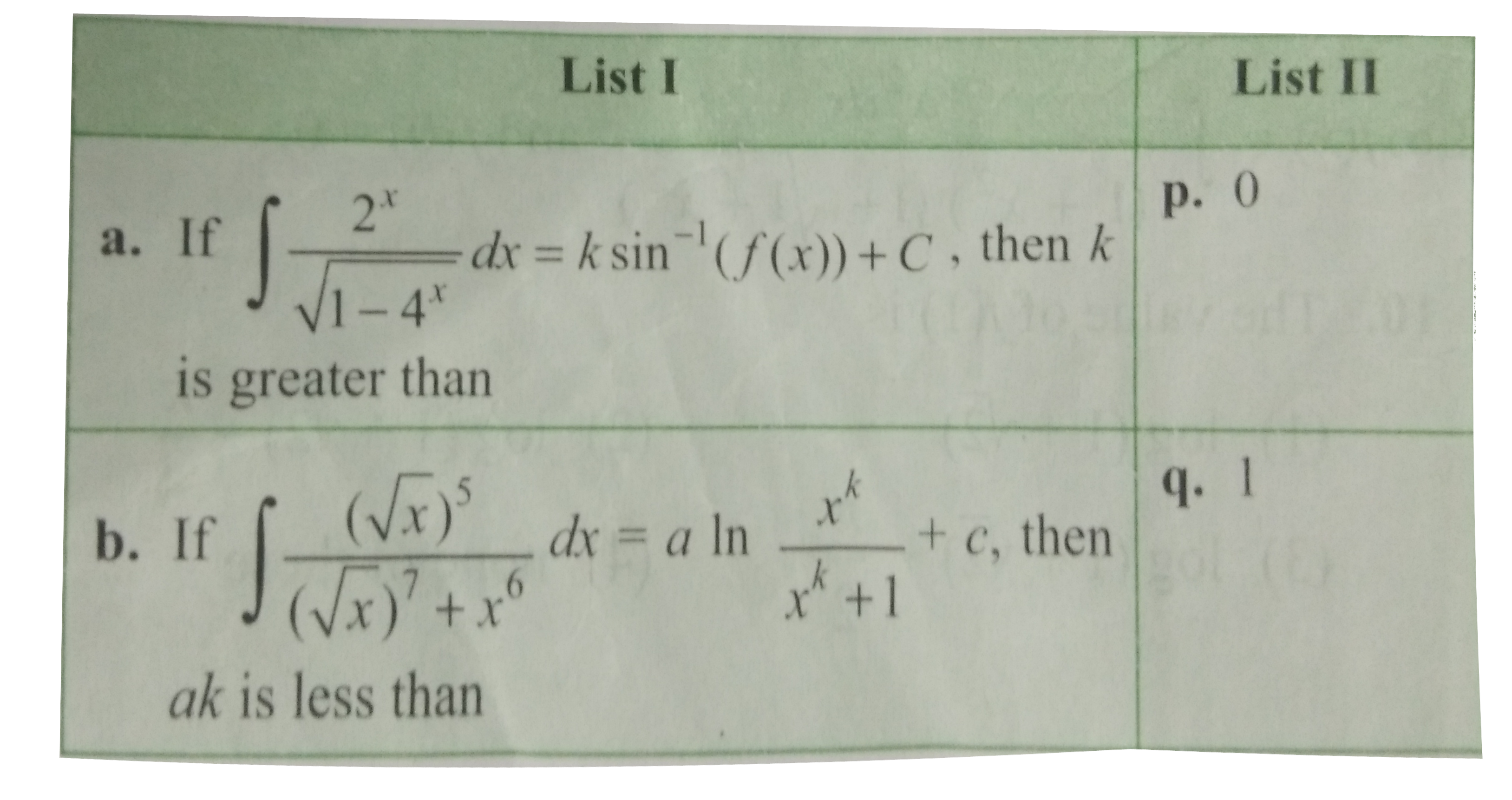Euler's substitution:
Integrals of the form ∫R(x,√ax2+bx+c)dx are claculated with the aid of one of the following three Euler substitutions:
i. √ax2+bx+c=t±x√aifa>0
ii. √ax2+bx+c=tx±x√cifc>0
iii. √ax2+bx+c=(x−a)tifax2+bx+c=a(x−a)(x−b) i.e., if α is real root of ax2+bx+c=0
xdx√7x−10−x23can be evaluated by substituting for x asSolution in Bengali
x=5+2t2t2+1
x=5−t2t2+2
x=2t2−53t2−1
none of these
The correct Answer is:A
In this case, a<0andc<0. Therefore, neither the first nor the second Euler substitution is applicable. But the quadratic 7x−10−x2 has real roots α=2,β=5. Therefore, we use the third Euler substitution:
√7x−10−x2=√(x−2)(5−x)=(x−2)t
or5−x=(x−2)t2
orx=5+2t2t2+1
Topper's Solved these Questions
- INDEFINITE INTEGRATIONBook:CENGAGE PUBLICATIONChapter:INDEFINITE INTEGRATIONExercise:EXERCISES (Matrix Match Type)
Explore 4 Videos
- INDEFINITE INTEGRATIONBook:CENGAGE PUBLICATIONChapter:INDEFINITE INTEGRATIONExercise:EXERCISES (Numerical Value Type)
Explore 10 Videos
- INDEFINITE INTEGRATIONBook:CENGAGE PUBLICATIONChapter:INDEFINITE INTEGRATIONExercise:Exercises (Multiple Correct Answers Type)
Explore 17 Videos
- HYPERBOLABook:CENGAGE PUBLICATIONChapter:HYPERBOLAExercise:COMPREHENSION TYPE
Explore 2 Videos
- INEQUALITIES AND MODULUSBook:CENGAGE PUBLICATIONChapter:INEQUALITIES AND MODULUSExercise:Single correct Answer
Explore 21 Videos
Similar Questions
Match the following lists:


View SolutionLet f(x)=∫xsinx(1+xcosx.lnx+sinx)dxandf(π2)=π24. Then the value of |cos(f(π))| is____
View SolutionEvaluate:∫dx√2ex−1=
View SolutionThe circle x2+y2−8x=0 and hyperbola x29−y24=1 I intersect at the points A and B. Equation of a common tangent with positive slope to the circle as well as to the hyperbola is (A) 2x−√5y−20=0 (B) 2x−√5y+4=0 (C) 3x−4y+8=0 (D) 4x−3y+4=0
View SolutionIf f(x)=ax2+bx+c and f(−1)≥−4, f(1)≤0 and f(3)≥5, then the least value of a is
View Solutionint sqrt(x)(ax^(2)+bx+c)dx
View SolutionEuler's substitution:
Integrals of the form ∫R(x,√ax2+bx+c)dx are claculated with the aid of one of the following three Euler substitutions:
i. √ax2+bx+c=t±x√aifa>0
ii. √ax2+bx+c=tx±x√cifc>0
iii. √ax2+bx+c=(x−a)tifax2+bx+c=a(x−a)(x−b) i.e., if α is real root of ax2+bx+c=0
Which of the following functions does not appear in the primitive of 11+√x2+2x+2 if t is a function of x ?
View SolutionEuler's substitution:
Integrals of the form ∫R(x,√ax2+bx+c)dx are claculated with the aid of one of the following three Euler substitutions:
i. √ax2+bx+c=t±x√aifa>0
ii. √ax2+bx+c=tx±x√cifc>0
iii. √ax2+bx+c=(x−a)tifax2+bx+c=a(x−a)(x−b) i.e., if α is real root of ax2+bx+c=0
Which of the following functions does not apear in the primitive of dxx+√x2−x+1 if t is a function of x?
View SolutionEuler's substitution:
Integrals of the form ∫R(x,√ax2+bx+c)dx are claculated with the aid of one of the following three Euler substitutions:
i. √ax2+bx+c=t±x√aifa>0
ii. √ax2+bx+c=tx±x√cifc>0
iii. √ax2+bx+c=(x−a)tifax2+bx+c=a(x−a)(x−b) i.e., if α is real root of ax2+bx+c=0
∫xdx(√7x−10−x2)3 can be evaluated by substituting for x as
View Solution√ax2+bx+c
View SolutionIf α and β are the roots of the equation ax2+bx+c=0 then ∫(x−α)(x−β)ax2+bx+cdx=
View Solutionx के सापेक्ष फलन के अवकल गुणांक निकालें
cos(ax2+bx+c)+sin3√ax2+bx+c
View SolutionIf 2, 3, 5 are the roots of ax3+bx2+cx+d=0 then the roots of ax√x+bx+c√x+d=0 are
View SolutionLet a, b, c be non zero numbers such that int_(0)^(3)sqrt(x^(2)+x+1)(ax^(2)+bx+c)dx=int_(0)^(5)sqrt(1+x^(2)+x)(ax^(2)+bx+c)dx . Then the quadratic equation ax^(2)+bx+c=0 has
View SolutionIf 1,2,3 are the roots of ax3+bx2+cx+d=0 then the roots of ax√x+bx+c√x+d=0 are
View SolutionEuler's substitution:
Integrals of the form ∫R(x,√ax2+bx+c)dx are claculated with the aid of one of the following three Euler substitutions:
i. √ax2+bx+c=t±x√aifa>0
ii. √ax2+bx+c=tx±x√cifc>0
iii. √ax2+bx+c=(x−a)tifax2+bx+c=a(x−a)(x−b) i.e., if α is real root of ax2+bx+c=0
xdx√7x−10−x23can be evaluated by substituting for x as
View Solution